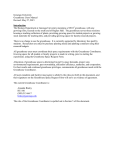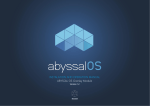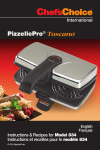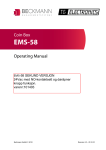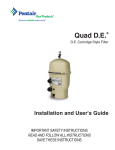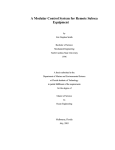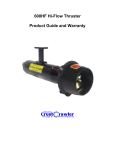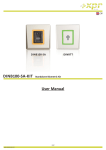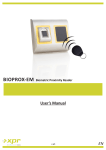Download technical report
Transcript
Table of Contents Abstract . . . . . . . . . . . . . . . . . . . . . . . . . . . . . . . . . . . . . . . . . . . . . . . . . . . . . . . . . . . . . . . . . . . . . 2 Budget . . . . . . . . . . . . . . . . . . . . . . . . . . . . . . . . . . . . . . . . . . . . . . . . . . . . . . . . . . . . . . . . . . . . . . 3 Software Block Diagram . . . . . . . . . . . . . . . . . . . . . . . . . . . . . . . . . . . . . . . . . . . . . . . . . . . . . . . . 4 S.I.D . . . . . . . . . . . . . . . . . . . . . . . . . . . . . . . . . . . . . . . . . . . . . . . . . . . . . . . . . . . . . . . . . . . . . . . . . 5 Design Rationale . . . . . . . . . . . . . . . . . . . . . . . . . . . . . . . . . . . . . . . . . . . . . . . . . . . . . . . . . . . . . . 6 Vehicle Systems . . . . . . . . . . . . . . . . . . . . . . . . . . . . . . . . . . . . . . . . . . . . . . . . . . . . . . . . . . . . . . 10 Troubleshooting. . . . . . . . . . . . . . . . . . . . . . . . . . . . . . . . . . . . . . .. . . .. . . . . . . . . . . . . . . . . . . . 11 Safety . . . . . . . . . . . . . . . . . . . . . . . . . . . . . . . . . . . . . . . . . .. . . . . . . . . . . . . . . . . . . . . . . . . . . . . 13 Challenges . . . . . . . . . . . . . . . . . . . . . . . . . . . . . . . . . . . . . . . . . . . . . . . . . . . . . . . . . . . . . . . . . . 14 Lessons Learned . . . . . . . . . . . . . . . . . . . . . . . . . . . . . . . . . . . . . . . .. . . . . . . . . . . . . . . . . . . . . . 15 Future Improvements . . . . . . . . . . . . . . . . . . . . . . . . . . . . . . . . . .. . . . . . . . . . . . . . . . . . . . . . . 16 Reflections . . . . . . . . . . . . . . . . . . . . . . . . . . . . . . . . . . . . . . . . . . . . . . . . . . . . . . . . . . . . . . . . . . 16 Teamwork . . . . . . . . . . . . . . . . . . . . . . . . . . . . . . . . . . . . . . . . . . . . . . . . . . . . . . . . . . . . . . . . . . 17 Project Management . . . . . . . . . . . . . . . . . . . . . . . . . . . . . . . . . . . . . . . . . . . . . . . . . . . . . . . . . . 18 Employees . . . . . . . . . . . . . . . . . . . . . . . . . . . . . . . . . . . . . . . . . . . . . . . . . . . . . . . . . . . . . . . . . . 20 References . . . . . . . . . . . . . . . . . . . . . . . . . . . . . . . . . . . . . . . . . . . . . . . . . . . . . . . . . . . . . . . . . . 21 Acknowledgements . . . . . . . . . . . . . . . . . . . . . . . . . . . . . . . . . . . . . . . . . . . . . . . . . . . . . . . . . . . 21 Gonzaga ROV | 1 Abstract In the harsh tundra like waters off the coast of the small province of Newfoundland there are several large oil reservoirs, both tapped and untapped. It is these oil reservoirs that serve not only as one of the province’s major sources of income but as an amazing front for Remotely Operated Vehicle (ROV) exploration. The province has four main drilling operations that serve to extract crude oil: Hibernia, Hebron, Terra Nova, and Sea Rose. On these platforms ROVs are used not only to perform repairs but also to carry out scientific research and help create new discoveries in the deep, frigid waters. There is also the potential to investigate ancient tundra ice in the form of icebergs with these ROVs. These icebergs can help us further understand our planet from its early days when it suffered the first great freeze. Here at Gonzaga ROV we have spent the past year attempting to design the best possible ROV to work in these unique conditions. As a result of a year of hardships and effort we managed to develop “Perseus” - our proud ROV named by popular vote. We believe that while being cost efficient and eco-friendly Perseus is perfectly equipped for all manner of subsea exploration off the Newfoundland coast and beyond. The success of Perseus in previous competitions and testing, serves to prove how even when faced with economic limitations and mechanical hardships ROVs can still be practically designed to accomplish all sorts of task. Within this report we outline all the challenges we have faced, the logistics behind our design, and how we prevailed even when placed in some tough situations. Gonzaga ROV is proud to present this technical report! Gonzaga ROV | 2 Budget Date 1/20/ 2015 1/20/ 2015 3/18/ 2015 2/3/ 2015 2/3/ 2015 4/6/ 2015 11/19 /2014 3/11/ 2015 4/30/ 2015 4/30/ 2015 5/28/ 2015 Type Category Expense Description Sources/No tes Amount Purchased Hardware Thrusters 4 thrusters -$2,696.00 Purchased Hardware Fasteners Purchased General Attachments Purchased Electronics ESCs Nuts, bolts, washers, Plasti-dip (donated), heat shrink Lasers, PVC pipe (donated), servo (donated), mirror (donated) Electronic speed controllers -$255.79 Purchased General Testing Trial motors, 14 gauge wire -$172.84 Purchased Hardware Wire 6 rolls of 12 gauge wire (100 feet/ roll) -$293.73 Parts donated Parts donated Re-used Hardware Frame Lexan Donated - Electronics Electronics Joystick, laptop, Arduino mega Donated - Electronics Underwater cam Donated - Cash donated Cash donated Cash donated Cash donated Cash donated General - Computer drive fundraiser General - Bake sale fundraiser General - 3rd Place MATE Regional Competition General - Participation $750 General - Clothing Swap/ Bake sale $167 -$38.43 -$8.47 $300 $208.33 $2,000 Total Raised Total Spent Final Balance Note: Because the 2015 competition was held In St. Johns, Newfoundland, the company did not incur any travel costs Gonzaga ROV | 3 $3,3422.83 $3,465.26 -$42.43 Software Block Diagram Gonzaga ROV | 4 S.I.D Gonzaga ROV | 5 Design Rationale The greatest challenge when it came to designing our robot was the chassis design. Having the need to completely replace our aging robot chassis we were tasked with the tedious task of starting from scratch. There were many design choices to consider. These included various geometric shapes; Cubes, rectangular prisms, spheres, or even ellipses. The ideas behind these designs were as follows. Both spherical and elliptical shapes were considered for a proposed alternative propulsion method involving the entire structure rotating with groves for thrust. After some calculations the spherical Figure 1A Sketch of the ROV before it was built design was deemed far too complex and difficult to control. While the elliptical design was easier, the creation of the elliptical shape was deemed much too labour intensive and therefore unreasonable. In the end, a standard rectangular design was chosen. A single sheet of Lexan was cut and bent into a rectangular prism without the base and the two smallest faces. This design was chosen because we could modify it (add attachments) much easier than with the latter choices. It allowed for the highest number of hard-points to place tools and systems. Further, any concerns regarding the hydrodynamics were seen to be inconsequential since chunks could be cut out to reduce surface area and therefore drag. Since there were no on-board electronics, there was no need to create a waterproof chamber within. Instead, a horizontal crossbar was added in order to improve the structural integrity of the chassis. This allowed for an additional location to potentially mount a camera or other tools. In regards to tools, we opted for simple tools. Our only moving tool is our claw. It in itself is simple in design featuring only one servo to control the closing action of the claw. Any other tools were decided to be non-moving parts. These were all made of pieces of Lexan. Two such pieces were mounted on the bottom of the crossbar. This enabled our robot to turn objects below it which Figure 2A picture of the ROV during the building process Gonzaga ROV | 6 have multiple protruding axles (valves). Such designs were specifically used with tasks in mind. The advantages of such tools include ease of manufacture and ease of replacement. Another advantage is the fact that such devices are easily altered to fit other needs, as well as being easily swappable. Another example of this is our forward prong which can be used to open or push various objects. The claw attachment to the ROV was made such that it could be used as the go-to tool in any range of situations. For this we needed a simple, yet effective design. After some thought, we decided on a pincer-like design, much like that of a crab claw (the most efficient designs can often be found in the natural world). We made the claw out of two sections, with only one section that moved. Figure 3A picture of the ROV during the building process This allowed the claw to be controlled with a single servo, making operation very easy as compared to that of a claw that uses multiple servos. The second attachment we created was more mission specific; this attachment was the bent piece of Lexan mounted on the bottom of the ROV. This piece would allow the ROV to catch onto the handles of a pipe valve and then turn it. It is very simplistic in design as it is simply a bent piece of Lexan, but it has proved very effective. Another mission specific attachment is the bottom facing prong designed to hook an O-ball. Since O-balls have a large amount of holes, we felt that if we could hook through one of these holes, we could trap the O-ball until it could be brought to the surface. However, a traditional sharp prong would be a safety concern. This meant we had to think outside the box, leading us to develop a prong that used multiple zip-ties in the place of prongs. In testing, this could reliably trap an O-ball, while posing no safety hazard. Finally, we needed to create an attachment to collect algae (represented by Ping-Pong balls). Firstly, we needed a view of the ping pong balls. With one camera, this could only be possible with a mirror. After we had attached the mirror, we created a basketlike attachment that used two elastic band as a top. This would Figure 4A picture of the ROV during the regional competition Gonzaga ROV | 7 allow the ping pong ball to be pushed through the elastic bands when we applied sufficient upward thrust, but would trap the ping pong ball inside until it could be brought to the surface. When it came to camera placement, prudence was required. Much thought was put into this task. Several mounts were considered, including a dual mount for stereoscopic 3-D support and a gyroscopic mount. The gyroscopic mount was discarded due to energy limitations. The latter was discarded due to it being deemed unnecessary and over-expensive with our modest budget. Camera was ultimately placed as an attachment to the upper face of the chassis. The angled camera allowed for excellent views of the fore-mounted tools. In addition to this, we had a mirror positioned in view of the camera so that we could have a view of what was above the ROV. This was mainly designed to address the algae sample retrieval task mentioned previously, but it also proved useful when navigating as it allowed us to determine the position of the ROV in relation to the ice sheet. Choice of thrusters was perhaps the most Figure 5A picture of an ROV thruster important decision that had to be taken on. We researched different motor types and found two main types: brushed and brushless. Through our research, we found that brushless motors would be the most efficient and so we placed a preference towards brushless motors. Then, we researched commercially available ROV thrusters that fit within our budget, finding only a few options, all of which were approximately the same price. However, after comparing specifications, we realized that the 400 HFS thrusters would offer the best performance, likely due to their brushless design. This brushless design would mean our electronics would have to be revamped. To control brushless motors we discovered that Electronic Speed Controllers (ESCs) were necessary. Using current usage specifications provided by Crustcrawler, we selected 100A Quik Car ESCs to control our motors. This choice was mostly influenced by the large range of voltage that the Quik ESCs can handle (up to 17V), the very high current rating and the affordable price. Finally, we had to consider the problem of motor control. After a failed attempt with using an Xbox 360 Controller to control the ROV, we decided to instead use a joystick intended more towards flight simulation. After, testing the usability of such a joystick we decided to use it. Gonzaga ROV | 8 Then came the problem of interfacing with the ESCs via program. After some research, we discovered that ESCs could be controlled via a simple servo signal (square wave). This could be easily generated via an Arduino, which is a commonly available micro controller. Creating a program to interface with the Arduino and joystick was challenging, as our chief programmer was skilled in JavaScript, which is not typically used to interface with hardware. After some more research, the library Johnny-Five for node.js was found – this would allow us to interface with an Arduino. However, there were no libraries to interface with a joystick of our type, so we decided to create such a library in-house. Figure 6 Control Box w/ ESC’s pictured bottom left After all this, we considered motor placement carefully. After much thought, we opted for two horizontal motors and two vertical. Our vertical motors are mounted on the upper portion of our robot, such that the robot has the ability to yaw. The same was done with the horizontal motors; they were positioned such that we could rotate our ROV around its center of gravity. To summarize, our design was based upon the greatest versatility and performance for the simplest design. It is a testament to our engineers and the construction crew's abilities. We believe we have built a device worthy of use for years to come. Figure 7A picture of an employee holding the ROV Gonzaga ROV | 9 Vehicle Systems For the 2015 competitions, we decided to revolutionize our robot with all new designs and parts. To achieve this, our team combined lessons learned from previous years with a great deal of new research to find the best designs and maximize efficiency. Our main goal this year was to reduce the size of our ROV. One of the most effective ways to do this was eliminating some of our thrusters (we previously had six bilge pump motors). Much time, testing and research were used in finding the correct thrusters for our ROV. Our original ideas included improving on the bilge pumps previously on the vehicle and waterproofing smaller DC motors, which would weigh less and take up less space. Our testing proved useful here, as we discovered that the DC motors although small would have been difficult to waterproof and would not output more thrust than we already had. After considering our budgetary allotment we decided the best idea was to invest in 400 HFSL Hi-Flow ROV thrusters from Crustcrawler. To reduce our costs we only purchased four Figure 8A picture of the ROV during the building process thrusters; which proved sufficient due to the high thrust output per motor. To accommodate the thrusters, a new frame had to be built. The frame had to be built such that it could incorporate the thrusters directly without an overly complex bracket system. The material we chose for the frame was Lexan. Lexan was chosen for its high strength and the relative ease with which we could manipulate it. In addition, we had had experience using Lexan for frame construction from our previous years in the MATE competition. With new missions came new tools. Our team’s skill in innovation was put to the test as we created different tools to accommodate this years missions. Many of the tools created were stationary and for specific missions. Despite this, the team unanimously decided that we were limited by not having a motorized claw, so we built one that could carry items up to four inches in diameter. Our claw design was based solely on the items it needed to carry during the Gonzaga ROV | 10 missions, while also allowing some flexibility so that if needed the claw could be used to fulfill other mission tasks for which it was not originally designed. The new thrusters also needed a new electrical system. Our previous tether, when tested proved to have a large amount of resistance, therefore not allowing us to run the thrusters to their full potential. This was alleviated through the use of 12 gauge wire in our tether. We also had to add in four new electronic speed controllers (ESCs) to be able to control our motors. These ESCs would also allow us to control the speed of our motors, and use the motors in reverse. The final aspect added to our electronics was a programmable Arduino microcontroller which allowed us to upgrade our controls from switches to a joystick for precision driving. Troubleshooting During construction of our robot we ran into a few difficult issues that were addressed by our team and repaired or improved. Through troubleshooting, and a multitude of issues, our whole team not only learned more about our robot but about construction principles in general. The first major issue we encountered was a mounting issue that was affecting our motors ability to move. When we had designed our frame we had several team meetings until we all settled on a design we all liked as a group. Following that, we had our mechanical engineer create a sketch in Google Sketch Up and build it. Early in the project, when we installed our motors and had a test run, we found that the horizontal motors were stuttering as if something was impeding their movement. So, we proceeded to shut the ROV down and test the ability of the propellers to spin using our fingers. We found that there was in fact some resistance when we spun the propellers - which meant that something was impeding the movement of the motor shaft. Upon investigation, we found that the screws used to attach the motor to our mounting bracket were in fact long enough to scrape the moving shaft of the motor. So, we removed the screws and created a new Lexan bracket that would remove the need to use the screws. We then sealed the holes as they exposed the motor shaft and tested it again. We found success in this run. Through troubleshooting this problem we learned that homemade solutions can be the best as compared to traditional solutions. Gonzaga ROV | 11 The second major issue that we encountered was a calibration issue in our Electronic Speed Controllers (ESC’s). When setting up ESC’s there is normally a one time control range calibration that needs to be done and they are ready to be used for controlling motors. However, when we set our range we found that our motors were having varied degrees of effectiveness, such as having a rough start up or being unable to go in-reverse. In order to troubleshoot this, we first looked at the control program’s code and double checked there were no errors in the programming. We also checked to make sure that we had the same settings being applied to each motor. After verifying that, we proceeded to check the motors for damage or Figure 9 A picture of the control box of the ROV motion impeding issues like we had experienced earlier and found none. We then checked the pulse widths coming out of the ESC’s to make sure that they were actually sending a signal to our motors and they were. After testing all the obvious possibilities we read online that ESCs could only accept PWM signals with a pulse width of 1000-2000 μs. We decided to try and change this from the control program. We also changed reverse thrust settings and start-up speed settings on the ESCs. In the end, this gave us a setup that worked with the motors. Through this issue, we learned that sometimes the simplest solution is the best; we had assumed that the issue was a bigger deal than it was and spent hours troubleshooting what should have been an easy fix. It also taught us that all parts of a system are important and need to be checked while trying to find a problem. The last issue we encountered was related to the tether we were using to transmit power and control signals to our motors. As we were testing our ROV, we found that the motors were not working as in the way that we had seen in videos. So, we decided to look for a way to improve this. The first thing we did was checking the motors themselves for damage, to make sure we did not damage them in installation and testing. We could not find any issues with our motors when we checked them, so we moved on to attempting to alter our program to no success. Finally, out of ideas, we decided to check the amount of resistance in our wires to check if that could be our problem, and sure enough we found that the resistance was quite high. We checked the wires in our tether and discovered we were running high current motors through a small gauge (about 20 AWG) wire. This contradicted what we understood was in the tether so we had to design our own tether out of lower gauge wire to mitigate this resistance problem. We made our new tether out of 12 lengths of 15.2m, 12 AWG wire. By doing this, we increased the cross sectional area of the wire, thereby decreasing its resistance. From this Gonzaga ROV | 12 problem, we learned that one should double check materials before using them, as this problem could have been avoided entirely if we had confirmed the wire gauge of our tether. Figure 10 A picture of the tether connected to the ROV Figure 11 A picture of the tether connected to the ROV Safety At Viking Tech, ensuring everyone’s safety regarding our ROV is top priority. Our philosophy regarding safety is that each member should have a full understanding of their surroundings and is aware of the precautions they must take. Even things as simple as wearing appropriate clothing and having a clean work space is are for avoiding injuries. Our safety protocol while in the workshop is: • Always wear safety glasses and proper clothing • Have full understanding of a machine before using it, and have someone with you at all times • When handling objects that are hot, always wear safety gloves • When around harmful chemicals, always wear a mask to cover your mouth and nose • If you do not feel comfortable doing a job, you are not obliged to do it • After using a harmful tool, always return it to its rightful place to avoid injuries • Act sensible around machines Gonzaga ROV | 13 On our ROV, we used Plasti-Dip on all bare wires to avoid short any potential short circuits. We also used yellow Caution tape on the protective barrels around the propellers to prevent future accidents from happening. To ensure complete safety, we even filed the edges of our ROV’s frame to a curve to exclude any sharp edges. The best safety precaution is a careful worker, so we encourage our team to practice safety and take it seriously. Figure 12 A picture of an employee filing the sharp edges off the tether Figure 13 A picture of an employee taping over a soldered wire Challenges While preparing for the competition, our company encountered two major challenges in the technical and non-technical aspects of ROV construction. The main technical challenge that we encountered was the erratic and unreliable performance of our motors during initial testing. This issue threatened to put our team out of contention if it was not solved. However, through extensive troubleshooting we discovered the two underlying problems responsible; the first of these was that the high gauge of the tether wires (20 AWG) was causing heavy power loss and the second being that some Arduino pins were not functioning properly. We fully restored the use of our motors by building a new tether with lower gauge wire (12 AWG) and switching Arduino pins. The primary non-technical challenge for our company was scheduling meeting times. Many of our members were engaged in school activities or other work throughout the week, and thus a singular meeting day would not work. We polled our group members about which days were best, and scheduled our twice weekly meetings accordingly. This would allow each member to be present to at least one of the meetings Gonzaga ROV | 14 Lessons Learned Throughout the entire build process we learned a multitude of lessons. These lessons included knowledge about electrical motors, the usage of power tools, and of course, effective organization of a group of people in which each member's role can vary significantly. The first main lesson we learned was the usage of electrical motors. Many of the company members responsible for construction were new to the team and had no experience with how electrical motors worked. Through research, we gained valuable knowledge about power transmission, speed control and even the inner design of the motors. For this, it was particularly helpful to have small test motors to demo our designs, and learn the inner workings of a motor, without risking our costly main motors. This knowledge of motors is invaluable, as installing and operating similar motors will undoubtedly be a key aspect of some of our careers. Many of our team members had also had no Figure 14 A picture of one of the ROV’s motors experience with operating power tools; a critical aspect of ROV construction. Through our supervisors and mentors, we all learned how to safely operate the tools each of us would need to use in our varied roles. This again was invaluable as almost any of the technical job sectors would require the use of power tools. Finally, some of our members learned how to effectively carry a leadership position. At first, they had little experience with leadership and found organisation could take a long time, especially when they had to consider everyone’s varied roles. However, as time went on, they became more adept at organization and leadership of the team, to the point where these skills now come easily and fluently. This has prepared the team members with leadership roles for future careers where they will have to take the lead once again. Figure 15 A picture of an employee learning to solder a wire Gonzaga ROV | 15 Future Improvements From the problems we encountered with our motors, as well as during our in-water experiences we have created a plan for future improvements. This plan involves placing some of our electronics on-board the ROV and the installation of a second camera. Due to the problems we had with power transmission to the motors, we feel that we would benefit from on-board electronics. This is due to the fact that such an improvement would allow us to use only two wires for the majority of power transmission, which could be an even lower gauge than our current 12 AWG, to ensure that we have absolutely no more problems with power transmission. This would also allow us to have a more streamlined and easier to manage tether. Additionally, from our in-water experience, we found that we had some difficulty spotting objects, especially those below us. Because of this, we feel that a second, downward facing camera should be added to the ROV to make sure we have no more vision problems. Figure 16 A picture of the ROV control box Reflections In reflection, our year with Gonzaga ROV was fraught with many challenges; challenges that we overcame and challenges that taught us much. These challenges taught us things from every aspect of ROV creation, from design and assembly to electronics and software. But, more importantly, it taught us concepts such as teamwork and leadership, creating an impact on us that will last us the rest of our lives. Gonzaga ROV | 16 Teamwork Designing, constructing and operating an ROV like Perseus to an advanced level involves all members of a dedicated team. Different members of our group were tasked throughout the year with separate jobs to ensure that the robot, as well as the poster were completely finished in time of the competition. Group member’s roles were based upon skills that were valuable for certain areas. We also set deadlines for team members to ensure that they were completing their tasks well in advance of their due dates. With our writing and computer team, the different report sections were categorized and then equally divided among a group of people to ensure quality and efficiency of work. When building the ROV itself we had different members build different sections, such as the claw, the frame, and the thruster brackets. We also had different members who programmed the robot as well as complete the complex electronic systems present on Perseus. This project has taught all team members the values of teamwork. It helped to bring similarly minded people together to accomplish something great and develop long lasting friendships. We learned cooperation, management, and work ethic through our experiences together. Figure 17A picture of the team at the Regional competition Gonzaga ROV | 17 Project Management Near the beginning of the year, it was established that company meetings would take place twice a week on Mondays and Wednesdays. Because not all members could attend both Monday and Wednesday (due to other commitments) a lunchtime meeting on Tuesdays was put in place so members who did not attend both practices would not be out of the loop. After a few weeks of unorganized meetings a schedule was established as shown below. Whenever something needed to be done it was added to the schedule and given a deadline. Creation and enforcement of deadlines was handled by Gonzaga ROV C.E.O. Andrew Nash. Andrew identified what needed to be done by personally talking to each company employee. Using each employees input and information received from consultation with the heads of each branch of Gonzaga ROV, he planned out what needed to be done and gave each team member a role. This was especially effective when he hosted a team meeting after the MATE regional competition. The team went through every task and questioned each other on how they were going to do it better at the international competition. Once Andrew had taken note on what improvements needed to be done, he created deadlines for each one. These deadlines were essential in organizing the team. Deadline Date Objective Result 10/15/2014 First meeting/ Gather team members Complete 10/20/2014 Assign Roles Complete 10/22/2014 Start ROV Design Complete 10/27/2013 Assign Poster team roles Complete 11/3/2014 Finish ROV design and start ordering parts Complete 11/10/2014 Make sure all parts ordered and start building frame Complete 11/19/2014 Start coding controller Complete 11/24/2014 Finish ROV frame/ wait for motors Complete 12/15/2014 Test Motors arrive/ Order actual motors Complete 12/17/2014 Finish controller program Complete 1/20/2015 Motors Arrive Complete 1/21/2015 Start installation of motors Complete Gonzaga ROV | 18 2/9/2015 Finish installation of motors Complete 2/11/2015 Begin bug testing program/ESC's Complete 2/23/2015 Start finalizing Poster Complete 3/4/2015 Begin to design attachments for missions Complete 3/9/2015 Attach "legs" to ROV and build stand Complete 3/11/2015 Print poster Complete 3/16/2015 Attach mirror & Ping-Pong ball trap Complete 3/18/2015 Attach O-ball trap Complete 3/23/2015 Double check all safety Complete 3/20/2015 Begin in water testing Complete 4/1/2015 Determined motor #3 faulty. Order new motor Complete 4/6/2015 Re-design ROV vertical to use 1 motor Complete 4/11/2015 Finish 3 Motor upgraded ROV Complete 4/13/2015 Resume in water testing Complete 4/30/2015 Qualify for Internationals Complete 5/4/2015 Review of Regionals Complete 5/6/2015 Assign roles for Tech Report Complete 5/8/2015 Install 4th motor Complete 5/20/2015 Collect all pieces of Tech Report Complete 5/25/2015 Compile Tech Report Complete 5/28/2015 Send tech report to MATE center Complete 6/1/2015 Attach bilge pump to ROV Incomplete 6/3/2015 Attach laser system to ROV Incomplete 6/8/2015 Begin in water testing Incomplete Note: This report was submitted on May 28th, 2015 so some deadlines may be missing or incomplete Gonzaga ROV | 19 Employees From left to right Row 1 (top): Joshua Veber – Chief Mechanical Engineer Row 2 (Second to top): Adam Manuel – Co-Pilot/ Electrical Engineer, Steven Nerehim – Electrical Engineer, Stephen Pollett – Pilot/ Electrical Engineer, Michael Collis – Media/ Human Resources Row 3 (Second to bottom): Robyn Bulgin – Safety Officer/ Research Scientist, Richelle Bulgin – Human resources, Zhipu Zhang – Communications Officer/ Design Row 4 (Bottom row): Andrew Nash – C.E.O, Anton Afanassiev – CTO/Chief Programmer, Nitish Bhatt – Financial Officer, Bridget Kenny – CFO/ Human Resources Gonzaga ROV | 20 Acknowledgments Gonzaga ROV would like to thank all the sponsors of the 2015 MATE ROV competition. We are especially grateful to our mentor Andrew Walsh, who taught us much and was with us through all the tough spots. We would also like to thank our teacher sponsors - Mr. Burke, Mr. Power and Mrs. Curtis, without whom this would not be possible. Also, we would like to thank Mr. van Nostrand and Mr. Ledrew, for their generous support for our company. We would also like to thank Oceaneering Canada Ltd. for providing advice and mentorship. References Crustcrawler Inc. (2015) 400 HFS-L Hi-Flow Thruster Product. Retrieved from http://www.crustcrawler.com/products/urov2/docs/HiFlow_Thruster_400HFSL_User_Guide_and_Warranty.pdf MATE ROV (2015) 2015 MATE ROV Competition Manual. Retrieved from http://www.marinetech.org/files/marine/files/ROV%20Competition/2015%20files/RAN GER_MANUAL_v6b_cover.pdf User Manual of Quik Series ESC for Car (n.d.) Retrieved from http://www.hobbyking.com/hobbyking/store/uploads/764731122X1256999X25.pdf Gonzaga ROV | 21























